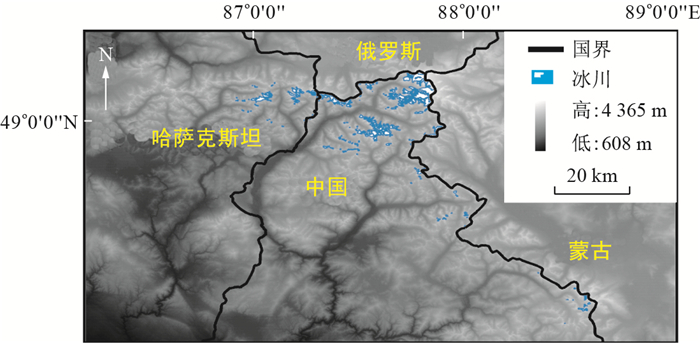Characteristics of glacial lakes in the central part of the southern Altai Mountains from 1972 to 2017 and their responses to climate changes
-
摘要: 以1972、1989、1996、2006、2017年5个不同时段的Landsat MSS/TM/ETM+/OLI遥感影像数据、数字高程模型(DEM)数据和气象数据为数据源,通过计算机自动提取与人工目视解译相结合的方法获取南阿尔泰山中部地区各时段的冰湖信息,利用GIS空间分析方法对该地区的冰湖面积进行统计,并分析研究区冰湖在不同规模、不同坡度、不同海拔状态下的时空变化特征。结果表明:①近45年来南阿尔泰山中部地区的冰湖面积呈"先减后增"趋势。1972-1996年研究区的冰湖面积从411.14 km2减少至400.83 km2,共减少了10.31 km2,减少速率为0.43 km2/a。从1996-2017年冰湖面积增加了15.42 km2;增长率为0.514 km2/a。②研究区冰湖分布主要集中在海拔低于2 200 m、坡度小于25°的区域,不同海拔区间和不同坡度区间的冰湖面积均呈"先减后增"趋势。③结合气温、降水、冰川面积以及冰储量变化数据分析发现,南阿尔泰山中部地区冰湖对气候变化具有明显的响应。温度、降水量及冰川融水是影响冰湖面积变化的主要因素;且这三者之间存在一种平衡关系,即温度升高冰川消融速度加快,从而对冰湖的收支平衡产生直接影响。当冰湖的补给量(即冰川融水和降水量之和)大于由温度升高引起的蒸发量时,冰湖面积会呈增长趋势;反之亦然。1970-1980年整个阿勒泰地区年代际降水量减少了19.28 mm,温度上升了0.25℃,因此1972-1989年研究区冰湖的蒸发水量大于补给水量,导致该时段冰湖面积呈退缩态势。1989-1996年该区降水量增加了19.67%,温度升高了0.62℃,但是增加的降水量却无法弥补由温度升高引起的冰湖蒸发量,因此1989-1996年研究区冰湖面积仍处于退缩状态。1996-2017年由于温度和降水量大幅增加导致冰湖面积呈不断增长趋势。Abstract: This paper used the Landsat MSS/TM/ETM/OLI remote sensing image data, digital elevation model (DEM) data and meteorological data from five different periods in 1972, 1989, 1996, 2006 and 2017 are used as data sources, and obtained the glacial lake information in the central part of South Altai Mountains by the method of automatic computer extraction and manual visual interpretation. This paper counted the area of glacial lakes in this area by GIS spatial analysis method, and analyzes the glacial lakes in different scales in the study area. The paper also analysed the slope, temporal and spatial variation characteristics at different elevations. The results show that: ① In the past 45 years, the area of glacial lakes in the central part of South Altai Mountains showed the trend of "decreasing at first and then increasing". From 1972 to 1996, the area of glacial lakes in the study area decreased from 411.14 km2 to 400.83 km2, a total of 10.31 km2 was reduced. The reduction rate of ice lake was 0.43 km2/a. From 1996 to 2017, the area increased by 15.42 km2; to 0.514 km2/a. ②The distribution of ice lakes in the study area is mainly concentrated in the area where the elevation is lower than 2 200 m and the slope is smaller than 25°.The area of glacial lakes in different altitude range and different slope range shows the trend of "decreasing first and then increasing". ②Combining with the analysis of temperature and precipitation data, we find that the change of glacial lake area in the central part of South Altai Mountains has obvious response to regional climate change. Temperature, precipitation and glacier melt water are the main factors affecting the change of glacial lake area. There is an equilibrium relationship among them, that is, the melting rate of glacier increases with the increase of temperature, which has an impact on the balance of revenue and expenditure of glacial lake. When the recharge amount of glacial lake (that is, the sum of glacier melt water and precipitation) is larger than the evaporation caused by rising temperature, the area of glacial lake will increase, and vice versa. The interdecadal precipitation of the whole Altay region decreased by 19.28mm from 1970 to 1980. The temperature increased by 0.25℃, which also led to the evaporation of glacial lake in the study area from 1972 to 1989, larger than that of recharge water, so the area of glacial lakes shrank during this period. From 1989 to 1996, the precipitation in this area increased by 19.67%, and the temperature increased by 0.62℃, but the increased precipitation cannot make up for the evaporation amount of glacial lake caused by the increase of temperature. Therefore, the area of glacial lakes in the study area from 1989 to 1996 is still in a state of retreat. From 1996 to 2017, the area of glacial lakes showed a growing trend due to the increase of temperature and precipitation.
-
表 1 遥感影像数据
Table 1. Data of the satellite images
传感器 通道/列 时间 分辨率/m 云量/% MSS 155/026 1972-09-01 60 1 MSS 154/026 1977-07-09 60 2 TM 143/026 1989-08-25 30 1 TM 144/026 1989-09-10 30 5 TM 144/26 1996-08-20 30 9.44 TM 143/26 1998-08-04 30 1.15 ETM+ 143/26 2008-10-09 30 1.51 ETM+ 144/26 2006-09-09 30 0.03 OLI 144/26 2017-09-15 30 6.01 OLI 143/26 2017-08-23 30 5.98 表 2 1972-2017年南阿尔泰山中部地区的冰湖变化
Table 2. Changes of glacial lakes in the central region of the southern Altai Mountains from 1972 to 2017
冰湖面积/km2 冰湖面积变化/km2 冰湖面积误差/km2 < 0.1 km2 0.1~0.2 km2 > 0.2 km2 1972 411.14 — ±34.66 28.58 24.00 358.56 1989 405.68 -5.46 ±18.02 32.00 22.39 351.29 1996 400.83 -4.85 ±20.15 40.29 19.41 341.13 2006 406.65 5.82 ±20.25 41.39 19.70 345.56 2017 416.25 9.6 ±22.57 46.42 22.52 347.31 表 3 不同坡度区间的冰湖面积分布
Table 3. Area distribution of glacial lakes in different slope intervals
坡度/(°) 1972年 1989年 1996年 2006年 2017年 面积/km2 [0, 5) 175.46 175.14 176.35 179.90 185.52 [5, 10) 119.12 117.46 116.71 118.23 120.61 [10, 15) 56.25 55.29 54.33 54.68 55.54 [15, 20) 26.78 26.19 25.29 25.41 25.87 [20, 25) 13.89 13.86 12.77 12.82 13.04 [25, 30) 7.55 7.56 6.58 6.61 6.73 > 30 12.08 10.17 8.79 8.98 8.93 表 4 不同海拔区间的冰湖面积分布
Table 4. Area distribution of glacial lakes at different elevations
[485, 700)m [700, 1 000)m [1 000, 1 300)m [1 300, 1 600)m [1 600, 1 900)m [1 900, 2 200)m [2 200, 2 500)m 面积/km2 1972年 171.27 102.10 42.58 39.09 38.90 15.17 1.57 1989年 168.68 101.48 41.24 38.83 38.25 13.71 2.64 1996年 163.86 101.06 42.74 37.19 38.52 14.94 2.22 2006年 168.17 101.61 42.91 37.28 38.73 15.17 2.35 2017年 168.93 103.64 43.89 39.95 42.29 15.27 1.72 -
[1] Young O R, Steffen W.The Earth system:Sustaining planetary life-support systems[M].New York:Springer, 2009:295-315. [2] Kaab A, Berthier E, Nuth C, et al.Contrasting patterns of early twenty-first-century glacier mass change in the Himalayas[J].Nature, 2012, 488:495-498. doi: 10.1038/nature11324 [3] 沈永平, 王国亚.IPCC第一工作组第五次评估报告对全球气候变化认知的最新科学要点[J].冰川冻土, 2013, 35(5):1068-1076. http://www.wanfangdata.com.cn/details/detail.do?_type=perio&id=bcdt201305002 [4] 安志宏, 孙自永, 胡雅璐, 等.多年冻土区河流溶解性有机碳输出的研究进展[J].地质科技情报, 2018, 37(1):204-211. http://www.wanfangdata.com.cn/details/detail.do?_type=perio&id=dzkjqb201801028 [5] 姚治君, 段瑞, 董晓辉, 等.青藏高原冰湖研究进展及趋势[J].地理科学进展, 2010, 29(1):10-14. http://www.wanfangdata.com.cn/details/detail.do?_type=perio&id=dlkxjz201001002 [6] 陈晨, 郑江华, 刘永强, 等.近20年中国阿尔泰山区冰川湖泊对区域气候变化响应的时空特征[J].地理研究, 2015, 34(2):270-284. http://www.wanfangdata.com.cn/details/detail.do?_type=perio&id=dlyj201502007 [7] Zimmermann V M.The 1985 catastrophic drainage of a moraine-dammed lake, Khumbu Himal, Nepal:Cause and consequences[J].Mountain Research and Development, 1987, 7(2):91-110. [8] Clague J J, Evans S G.A review of catastrophic drainage of moraine-dammed lakes in British Columbia[J].Quaternary Science Reviews, 2000, 19(17/18):1763-1783. http://www.wanfangdata.com.cn/details/detail.do?_type=perio&id=b1a6bdceff126b3e8096408a23e6b1bd [9] Caroni E, Rosso R, Siccardi F.Water science and technology library[J].Water Resources Research, 2008, 37(43):39-59. http://link.springer.com/content/pdf/bfm:978-94-011-5147-4/1.pdf [10] Carey M.Living and dying with glaciers:People's historical vulnerability to avalanches and outburst floods in Peru[J].Global & Planetary Change, 2005, 47(2/4):134. http://www.sciencedirect.com/science/article/pii/S0921818104001912 [11] Huggel C, Haeberli W, Kääb A, et al.An assessment procedure for glacial hazards in the Swiss Alps[J].Revue Canadienne De Géotechnique, 2004, 41(6):1068-1083. doi: 10.1139/t04-053 [12] Post A, Mayo L R.Glacier dammed lakes and outburst floods in Alaska[R].Virginia: Department of the Interior United States Geological Survey, 1976. [13] Nie Yong, Sheng Yongwei, Liu Qiao.A regional-scale assessment of Himalayan glacial lake changes using satellite observations from 1990 to 2015[J].Remote Sensing of Environment, 2017, 189:1-13. doi: 10.1016/j.rse.2016.11.008 [14] Sun Jian, Zhou Tian-cai, Liu Miao, et al.Linkages of the dynamics of glaciers and lakes with the climate elements over the Tibetan Plateau[J].Earth-Science Reviews, 2018, 185:308-324. doi: 10.1016/j.earscirev.2018.06.012 [15] Quincey D J, Richardson S D, Luckman A, et al.Early recognition of glacial lake hazards in the Himalaya using remote sensing datasets[J].Global and Planetary Change, 2007, 56:137-152. doi: 10.1016/j.gloplacha.2006.07.013 [16] 田青林, 潘蔚, 李瀚波, 等.基于多源遥感数据的蚀变信息提取对比研究[J].地质科技情报, 2018, 37(6):218-225, 238. http://www.wanfangdata.com.cn/details/detail.do?_type=perio&id=dzkjqb201806027 [17] 刘立, 李长安, 高俊华, 等.基于北斗与InSAR的地质灾害监测关键问题探讨[J].地质科技情报, 2019, 38(6):141-149. http://www.wanfangdata.com.cn/details/detail.do?_type=perio&id=dzkjqb201906016 [18] Immerzeel W W, Kraaijenbrink P D A, Shea J M, et al.High-resolution monitoring of Himalayan glacier dynamics using unmanned aerial vehicles[J].Remote Sensing of Environment, 2014, 150:93-103. doi: 10.1016/j.rse.2014.04.025 [19] Georg V, Oliver K, Sigrid R, et al.Detecting Himalayan glacial lake outburst floods from Landsat time series[J].Remote Sensing of Environment, 2018, 207:84-97. doi: 10.1016/j.rse.2017.12.025 [20] Buchroithner M F.Problems of mountain hazard mapping using spaceborne remote-sensing techniques[J].Advances in Space Research, 1995, 15(11):57-66. doi: 10.1016/0273-1177(95)00075-P [21] 王立伦, 刘潮海, 王平.中国阿尔泰山的现代冰川[J].地理学报, 1985, 40(2):142-154, 197. http://www.cnki.com.cn/Article/CJFDTotal-DLXB198502005.htm [22] 王淑红, 谢自楚, 戴亚南, 等.阿尔泰山冰川系统结构、近期变化及趋势预测[J].干旱区地理, 2011, 34(1):115-123. http://www.wanfangdata.com.cn/details/detail.do?_type=perio&id=ghqdl201101014 [23] 易朝路, 崔之久.新疆阿尔泰山哈纳斯河流域冰川湖泊的分类与沉积类型[J].海洋与湖沼, 1994, 25(5):477-485, 575. http://qikan.cqvip.com/Qikan/Article/Detail?id=1605768 [24] 舒梅海.近25年阿尔泰山区冰川冰湖变化及特征[D].长沙: 湖南科技大学, 2017. [25] 项彩娟, 陈植华, 王涛, 等.基于小波分析的滇东北毛坪铅锌矿充水水源识别[J].地质科技情报, 2019, 38(6):231-240. http://www.wanfangdata.com.cn/details/detail.do?_type=perio&id=dzkjqb201906027 [26] 李均力, 盛永伟, 骆剑承.喜马拉雅山地区冰湖信息的遥感自动化提取[J].遥感学报, 2011, 15(1):29-43. http://www.wanfangdata.com.cn/details/detail.do?_type=perio&id=ygxb201101003 [27] 张月.基于遥感的羌塘高原南部地区冰川、湖泊动态变化研究[D].重庆: 重庆师范大学, 2013. [28] 刘美琳.多源遥感影像冰川提取技术方法与应用[D].兰州: 兰州交通大学, 2014. [29] 刘梅.高山冰川遥感提取方法研究[J].测绘与空间地理信息, 2017, 40(10):135-138, 143. http://www.wanfangdata.com.cn/details/detail.do?_type=perio&id=dbch201710040 [30] 王高峰, 张廷斌, 张建平, 等.遥感影像的冰川信息提取方法对比[J].地理空间信息, 2010, 8(3):43-46. http://www.wanfangdata.com.cn/details/detail.do?_type=perio&id=dlkjxx201003015 [31] 牛生明, 李忠勤, 怀保娟.遥感影像提取冰川信息方法研究[J].中国西部科技, 2014, 13(8):1-3. http://www.wanfangdata.com.cn/details/detail.do?_type=perio&id=zgxbkj201408001 [32] 陆家驹, 李士鸿.TM资料水体识别技术的改进[J].环境遥感, 1992, 7(1):17-23. http://www.cnki.com.cn/Article/CJFD1992-YGXB199201002.htm [33] 盛永伟, 肖乾广.应用气象卫星识别薄云覆盖下的水体[J].环境遥感, 1994, 9(4):247-255. http://www.wanfangdata.com.cn/details/detail.do?_type=perio&id=ygxb199404002 [34] 徐涵秋.利用改进的归一化差异水体指数(MNDWI)提取水体信息的研究[J].遥感学报, 2005, 9(5):589-595. http://www.wanfangdata.com.cn/details/detail.do?_type=perio&id=ygxb200505012 [35] Scott W C, Owen K, Miles E S, et al.Optimising NDWI supraglacial pond classification on Himalayan debris-covered glaciers[J].Remote Sensing of Environment, 2018, 217:414-425. doi: 10.1016/j.rse.2018.08.020 [36] Anshuman B, Mritunjay K, Singh P K, et al.A lake detection algorithm (LDA) using Landsat 8 data:A comparative approach in glacial environment[J].International Journal of Applied Earth Observations and Geoinformation, 2015, 1(38):150-163. http://www.sciencedirect.com/science/article/pii/S0303243415000057 [37] Shrestha A B, Aryal R.Climate change in Nepal and its impact on Himalayan glaciers[J].Regional Environmental Change, 2011, 11(Sup1):65-77. http://www.wanfangdata.com.cn/details/detail.do?_type=perio&id=6926b21f3104dc987671891a7aacb64c [38] Lacaux J P, Tourre Y M, Vignolles C, et al.Classification of ponds from high-spatial resolution remote sensing:Application to Rift Valley Fever epidemics in Senegal[J].Remote Sensing of Environment, 2007, 106(1):66-74. doi: 10.1016/j.rse.2006.07.012 [39] 彭玉刚, 崔伟敏.近55年来新疆阿勒泰地区气温变化特征及趋势分析[J].安徽农业科学, 2011, 39(13):7803-7806. http://www.wanfangdata.com.cn/details/detail.do?_type=perio&id=ahnykx201113098 [40] 沈伟, 艾成, 汤英, 等.新疆阿勒泰地区近55年降水量变化特征分析[J].人民黄河, 2011, 33(8):31-33, 36. http://www.wanfangdata.com.cn/details/detail.do?_type=perio&id=rmhh201108011 [41] 刘琼欢.中国冰湖遥感调查与水量估算[D].长沙: 湖南科技大学, 2016. [42] 冯童, 刘时银, 许君利, 等.1968-2009年叶尔羌河流域冰川变化:基于第一、二次中国冰川编目数据[J].冰川冻土, 2015, 37(1):1-13. http://d.wanfangdata.com.cn/Periodical/bcdt201501001 [43] 刘凯.近20年来印度河流域冰川变化研究[D].西安: 西北大学, 2018. [44] 李浩杰.基于多源遥感数据的疏勒河上游山区流域2000-2015年冰川变化研究[D].西安: 西北大学, 2017. [45] Yao T, Thompson L, Wei Y, et al.Different glacier status with atmospheric circulations in Tibetan Plateau and surroundings[J].Nature Climate Change, 2012, 2(9):663-667. doi: 10.1038/nclimate1580 [46] Daniel F, Laurent L, Geir M, et al.Substantial glacier mass loss in the Tien Shan over the past 50 years[J].Nature Geoscience, 2015, 8(9):716-722. doi: 10.1038/ngeo2513 [47] 姜盛夏, 袁玉江, 秦莉, 等.阿尔泰山历史时期气候水文变化特征分析[J].冰川冻土, 2017, 39(3):672-679. http://www.wanfangdata.com.cn/details/detail.do?_type=perio&id=bcdt201703025 [48] Oerlemans J.Extracting a climate signal from 169 glacier records[J].Science, 2005, 308:675-677. doi: 10.1126/science.1107046 [49] Raper B, Brown O, Braithwaite R J.A geometric glacier model for sea-level change calculations[J].Journal of Glaciology, 2000, 46(154):357-368. doi: 10.3189/172756500781833034 [50] 王秀娜.近40年来南阿尔泰山地区现代冰川变化及对气候变化的响应[D].兰州: 兰州大学, 2012. [51] 吕卉, 杨太保, 田洪阵, 等.北阿尔泰山近30年冰川变化研究[J].干旱区资源与环境, 2012, 26(10):69-76. http://www.wanfangdata.com.cn/details/detail.do?_type=perio&id=ghqzyyhj201210013 [52] 王旭, 周爱国, 孙自永, 等.1972-2009年念青唐古拉山西段冰湖分布及其变化特征[J].地质科技情报, 2012, 31(4):91-97. http://www.cnki.com.cn/Article/CJFDTotal-DZKQ201204017.htm [53] 刘晓尘, 效存德.1974-2010年雅鲁藏布江源头杰玛央宗冰川及冰湖变化初步研究[J].冰川冻土, 2011, 33(3):488-0496. http://www.wanfangdata.com.cn/details/detail.do?_type=perio&id=bcdt201103004 [54] 李治国, 姚檀栋, 叶庆华, 等.1980-2007年喜马拉雅东段洛扎地区冰湖变化遥感研究[J].自然资源学报, 2011, 26(5):836-846. http://www.wanfangdata.com.cn/details/detail.do?_type=perio&id=zrzyxb201105011 [55] 陈晓清, 崔鹏, 杨忠, 等.喜马拉雅山中段波曲流域近期冰湖溃决危险性分析与评估[J].冰川冻土, 2007, 29(4):509-516. http://www.wanfangdata.com.cn/details/detail.do?_type=perio&id=bcdt200704002 [56] 魏红, 马金珠, 马明国, 等.基于遥感与GIS的朋曲流域冰川及冰湖变化研究[J].兰州大学学报, 2004, 40(2):97-100. http://www.wanfangdata.com.cn/details/detail.do?_type=perio&id=lzdxxb200402022 [57] 谢自楚, 刘潮海.冰川学导论[M].上海:上海科学普及出版社, 2009. -





 下载:
下载:








